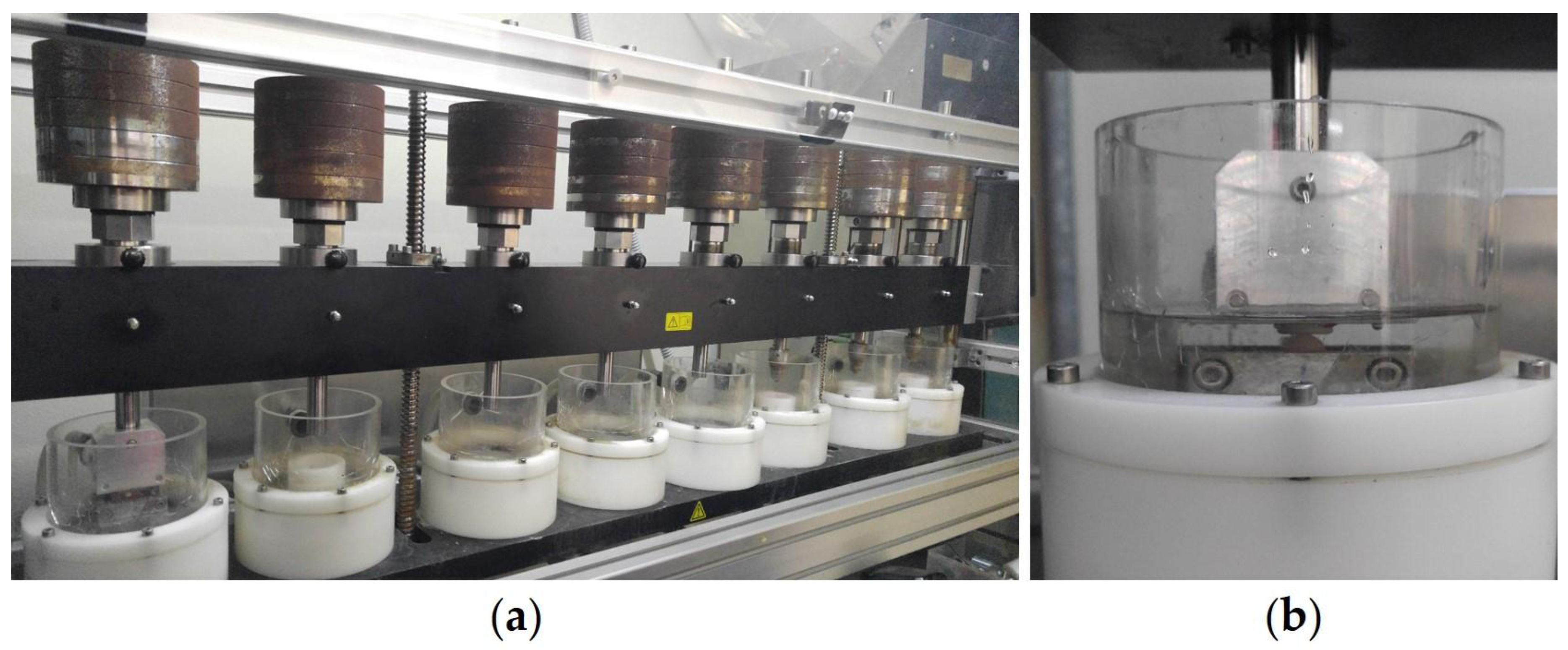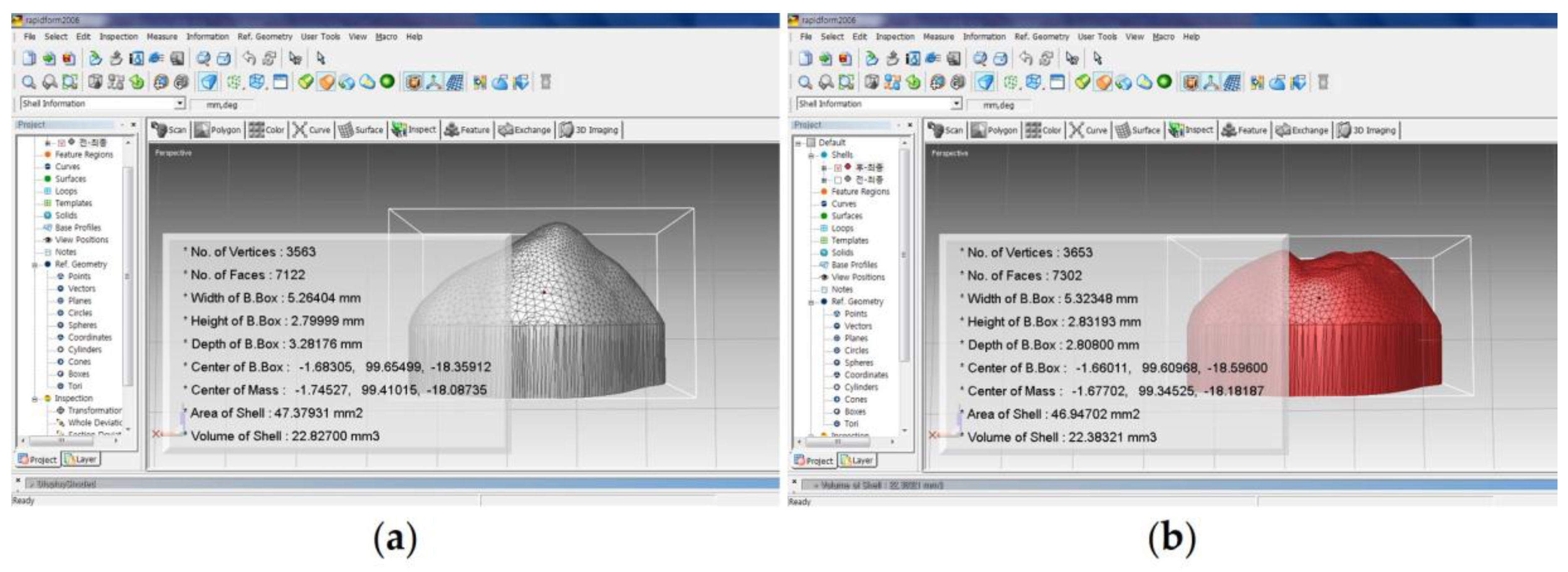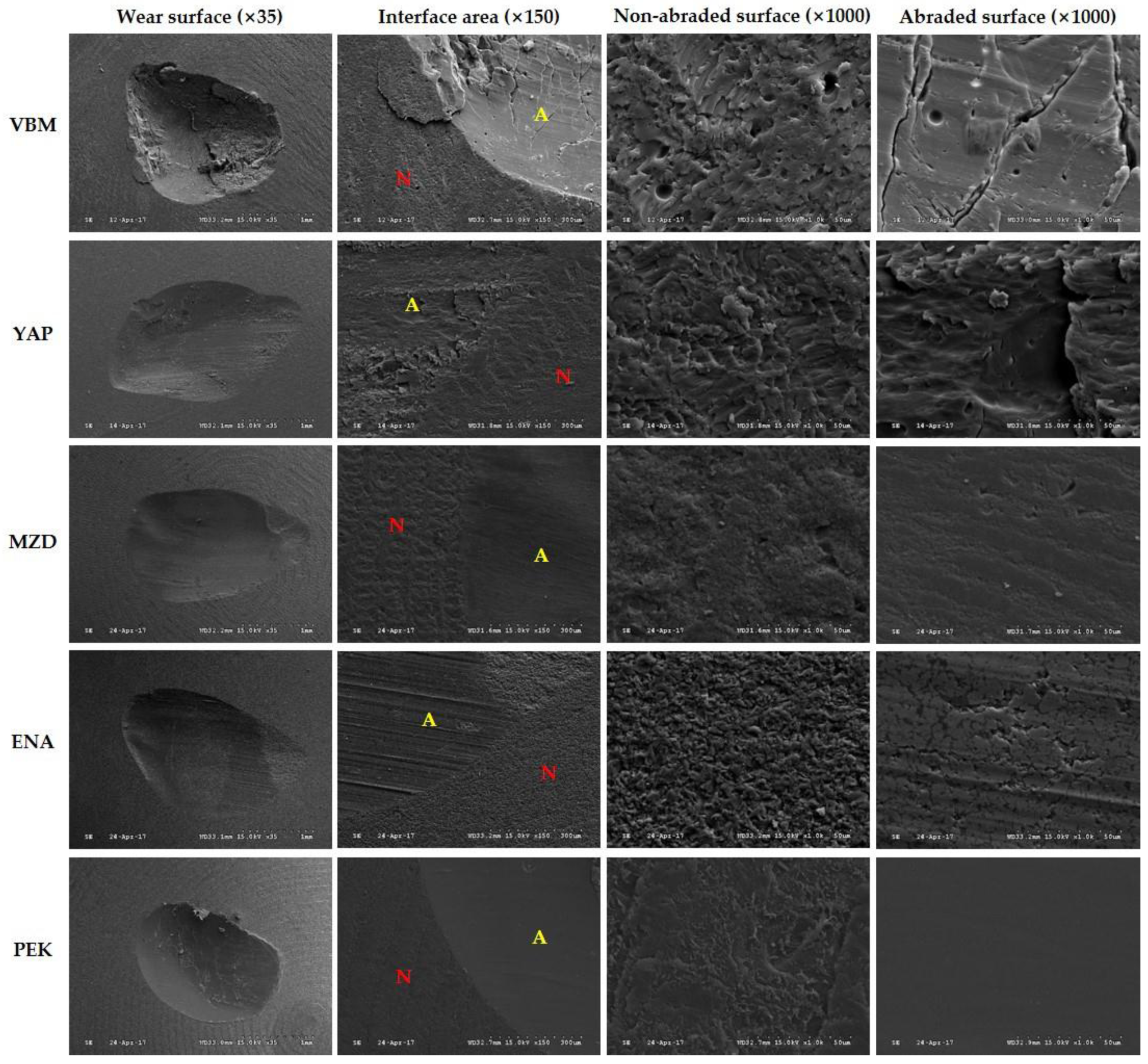In Vitro Investigation of Wear of CAD/CAM Polymeric Materials Against Primary Teeth
Abstract
:1. Introduction
2. Materials and Methods
2.1. Fabrication of the Antagonists
2.2. Fabrication of the Material Specimens
2.3. Wear Simulation
2.4. Wear Measurements
2.5. Scanning Electron Microscopy (SEM)
2.6. Statistics
3. Results
3.1. Wear Loss
3.2. Scanning Electron Microscopy (SEM)
4. Discussion
5. Conclusions
Author Contributions
Conflicts of Interest
References
- Lauvahutanon, S.; Takahashi, H.; Shiozawa, M.; Iwasaki, N.; Asakawa, Y.; Oki, M.; Finger, W.J.; Arksornnukit, M. Mechanical properties of composite resin blocks for CAD/CAM. Dent. Mater. J. 2014, 33, 705–710. [Google Scholar] [CrossRef] [PubMed]
- Wimmer, T.; Huffmann, A.M.; Eichberger, M.; Schmidlin, P.R.; Stawarczyk, B. Two-body wear rate of PEEK, CAD/CAM resin composite and PMMA: Effect of specimen geometries, antagonist materials and test set-up configuration. Dent. Mater. 2016, 32, e127–e136. [Google Scholar] [CrossRef] [PubMed]
- Alt, V.; Hannig, M.; Wostmann, B.; Balkenhol, M. Fracture strength of temporary fixed partial dentures: CAD/CAM versus directly fabricated restorations. Dent. Mater. 2011, 27, 339–347. [Google Scholar] [CrossRef] [PubMed]
- Barizon, K.T.; Bergeron, C.; Vargas, M.A.; Qian, F.; Cobb, D.S.; Gratton, D.G.; Geraldeli, S. Ceramic materials for porcelain veneers: Part II. Effect of material, shade, and thickness on translucency. J. Prosthet. Dent. 2014, 112, 864–870. [Google Scholar] [CrossRef] [PubMed]
- Zahran, M.; El-Mowafy, O.; Tam, L.; Watson, P.A.; Finer, Y. Fracture strength and fatigue resistance of all-ceramic molar crowns manufactured with CAD/CAM technology. J. Prosthodont. 2008, 17, 370–377. [Google Scholar] [CrossRef]
- Sripetchdanond, J.; Leevailoj, C. Wear of human enamel opposing monolithic zirconia, glass ceramic, and composite resin: An in vitro study. J. Prosthet. Dent. 2014, 112, 1141–1150. [Google Scholar] [CrossRef] [PubMed]
- Carvalho, A.O.; Bruzi, G.; Giannini, M.; Magne, P. Fatigue resistance of CAD/CAM complete crowns with a simplified cementation process. J. Prosthet. Dent. 2014, 111, 310–317. [Google Scholar] [CrossRef] [PubMed]
- Stawarczyk, B.; Özcan, M.; Trottmann, A.; Schmutz, F.; Roos, M.; Hämmerle, C. Two-body wear rate of CAD/CAM resin blocks and their enamel antagonists. J. Prosthet. Dent. 2013, 109, 325–332. [Google Scholar] [CrossRef] [Green Version]
- Nguyen, J.F.; Ruse, D.; Phan, A.C.; Sadoun, M.J. High-temperature-pressure polymerized resin-infiltrated ceramic networks. J. Dent. Res. 2014, 93, 62–67. [Google Scholar] [CrossRef] [PubMed]
- Awada, A.; Nathanson, D. Mechanical properties of resin-ceramic CAD/CAM restorative materials. J. Prosthet. Dent. 2015, 114, 587–593. [Google Scholar] [CrossRef] [PubMed]
- Della Bona, A.; Corazza, P.H.; Zhang, Y. Characterization of a polymer-infiltrated ceramic-network material. Dent. Mater. 2014, 30, 564–569. [Google Scholar]
- Spitznagel, F.A.; Horvath, S.D.; Guess, P.C.; Blatz, M.B. Resin bond to indirect composite and new ceramic/polymer materials: A review of the literature. J. Esthet. Restor. Dent. 2014, 26, 382–393. [Google Scholar] [CrossRef] [PubMed]
- Zhi, L.; Bortolotto, T.; Krejci, I. Comparative in vitro wear resistance of CAD/CAM composite resin and ceramic materials. J. Prosthet. Dent. 2016, 115, 199–202. [Google Scholar] [CrossRef] [PubMed]
- Coldea, A.; Swain, M.V.; Thiel, N. Mechanical properties of polymer-infiltrated-ceramic-network materials. Dent. Mater. 2013, 29, 419–426. [Google Scholar] [CrossRef] [PubMed]
- Stawarczyk, B.; Jordan, P.; Schmidlin, P.R.; Roos, M.; Eichberger, M.; Gernet, W.; Keul, C. PEEK surface treatment effects on tensile bond strength to veneering resins. J. Prosthet. Dent. 2014, 112, 1278–1288. [Google Scholar] [CrossRef] [PubMed] [Green Version]
- Schwitalla, A.; Müller, W.D. PEEK dental implants: A review of the literature. J. Oral Implantol. 2013, 39, 743–749. [Google Scholar] [CrossRef] [PubMed]
- Tannous, F.; Steiner, M.; Shahin, R.; Kern, M. Retentive forces and fatigue resistance of thermoplastic resin clasps. Dent. Mater. 2012, 28, 273–278. [Google Scholar] [CrossRef] [PubMed]
- Fuhrmann, G.; Steiner, M.; Freitag-Wolf, S.; Kern, M. Resin bonding to three types of polyaryletherketones (PAEKs)-durability and influence of surface conditioning. Dent. Mater. 2014, 30, 357–363. [Google Scholar] [CrossRef] [PubMed]
- Seligman, D.A.; Pullinger, A.G.; Solberg, W.K. The prevalence of dental attrition and its association with factors of age, gender, occlusion, and TMJ symptomatology. J. Dent. Res. 1988, 67, 1323–1333. [Google Scholar] [CrossRef] [PubMed]
- Mahoney, E.; Holt, A.; Swain, M.; Kilpatrick, N. The hardness and modulus of elasticity of primary molar teeth: An ultra-micro-indentation study. J. Dent. 2000, 28, 589–594. [Google Scholar] [CrossRef]
- Mair, L.H.; Stolarski, T.A.; Vowles, R.W.; Lloyd, C.H. Wear: Mechanisms, manifestations and measurement. Report of a workshop. J. Dent. 1996, 24, 141–148. [Google Scholar] [CrossRef]
- Proffit, W.R.; Fields, H.W. Occlusal forces in normal- and long-face children. J. Dent. Res. 1983, 62, 571–574. [Google Scholar] [CrossRef] [PubMed]
- Sales-Peres, S.H.; Sales-Peres, A.C.; Marsicano, J.A.; Carvalho, C.A.; Carvalho, F.S.; Lauris, J.R.; Sales-Peres, A. The relationship between tooth wear in the primary and permanent dentitions. Community Dent. Health 2011, 28, 196–200. [Google Scholar] [PubMed]
- Shah, P.V.; Lee, J.Y.; Wright, J.T. Clinical success and parental satisfaction with anterior preveneered primary stainless steel crowns. Pediatr. Dent. 2004, 26, 391–395. [Google Scholar] [PubMed]
- Choi, J.W.; Bae, I.H.; Noh, T.H.; Ju, S.W.; Lee, T.K.; Ahn, J.S.; Jeong, T.S.; Huh, J.B. Wear of primary teeth caused by opposed all-ceramic or stainless steel crowns. J. Adv. Prosthodont. 2016, 8, 43–52. [Google Scholar] [CrossRef] [PubMed]
- Lazaridou, D.; Belli, R.; Krämer, N.; Petschelt, A.; Lohbauer, U. Dental materials for primary dentition: Are they suitable for occlusal restorations? A two-body wear study. Eur. Arch. Paediatr. Dent. 2015, 16, 165–172. [Google Scholar] [CrossRef] [PubMed]
- D’Arcangelo, C.; Vanini, L.; Rondoni, G.D.; Pirani, M.; Vadini, M.; Gattone, M.; De Angelis, F. Wear properties of a novel resin composite compared to human enamel and other restorative materials. Oper. Dent. 2014, 39, 612–618. [Google Scholar] [CrossRef] [PubMed]
- Johansson, A.; Haraldson, T.; Omar, R.; Kiliaridis, S.; Carlsson, G.E. An investigation of some factors associated with occlusal tooth wear in a selected high-wear sample. Eur. J. Oral Sci. 1993, 101, 407–415. [Google Scholar] [CrossRef]
- Kim, S.K.; Kim, K.N.; Chang, I.T.; Heo, S.J. A study of the effects of chewing patterns on occlusal wear. J. Oral Rehabil. 2001, 28, 1048–1055. [Google Scholar] [CrossRef] [PubMed]
- Johansson, A.; Kiliaridis, S.; Haraldson, T.; Omar, R.; Carlsson, G.E. Covariation of some factors associated with occlusal tooth wear in a selected high-wear sample. Eur. J. Oral Sci. 1993, 101, 398–406. [Google Scholar] [CrossRef]
- Ghazal, M.; Hedderich, J.; Kern, M. Wear of feldspathic ceramic, nano-filled composite resin and acrylic resin artificial teeth when opposed to different antagonists. Eur. J. Oral Sci. 2008, 116, 585–592. [Google Scholar] [CrossRef] [PubMed]
- Willems, G.; Lambrechts, P.; Lesaffre, E.; Braem, M.; Vanherle, G. Three-year follow-up of five posterior composites: SEM study of differential wear. J. Dent. 1993, 21, 79–86. [Google Scholar] [CrossRef]
- Cha, H.S.; Lee, Y.K.; Lim, B.S.; Rhee, S.H.; Yang, H.C. Evaluation of wear resistance of dental resin composites with a 3D profilometer. J. Biomed. Mater. Res. Part B Appl. Biomater. 2004, 71, 414–420. [Google Scholar] [CrossRef] [PubMed]
- Rosentritt, M.; Siavikis, G.; Behr, M.; Kolbeck, C.; Handel, G. Approach for evaluating the significance of laboratory simulation. J. Dent. 2008, 36, 1048–1053. [Google Scholar] [CrossRef] [PubMed]
- Condon, J.R.; Ferracane, J.L. In vitro wear of composite with varied cure, filler level, and filler treatment. J. Dent. Res. 1997, 76, 1405–1411. [Google Scholar] [CrossRef] [PubMed]
- Lee, A.; He, L.H.; Lyons, K.; Swain, M.V. Tooth wear and wear investigations in dentistry. J. Oral Rehabil. 2012, 39, 217–225. [Google Scholar] [CrossRef] [PubMed]
- Mukatash-Nimri, G.E. Wear mechanisms and wear investigations of dental materials; A review of the literature. Arch. Oral Dent. Res. 2015, 2, 342–349. [Google Scholar]
- Krejci, I.; Albert, P.; Lutz, F. The influence of antagonist standardization on wear. J. Dent. Res. 1999, 78, 713–719. [Google Scholar] [CrossRef] [PubMed]
- De Gee, A.J.; Pallav, P.; Davidson, C.L. Effect of abrasion medium on wear of stress-bearing composites and amalgam in vitro. J. Dent. Res. 1986, 65, 654–658. [Google Scholar] [CrossRef] [PubMed]
- Teixeira, E.C.; Thompson, J.L.; Piascik, J.R.; Thompson, J.Y. In vitro toothbrush-dentifrice abrasion of two restorative composites. J. Esthet. Restor. Dent. 2005, 17, 172–182. [Google Scholar] [CrossRef] [PubMed]
- Prakki, A.; Cilli, R.; Amarante de Araújo, P.; Navarro, M.F.; Mondelli, J.; Mondelli, R.F. Effect of tooth-brushing abrasion on weight and surface roughness of pH-cycled resin cements and indirect restorative materials. Quintessence Int. 2007, 38, 544–554. [Google Scholar]
- Heintze, S.D.; Cavalleri, A.; Forjanic, M.; Zellweger, G.; Rousson, V. A comparison of three different methods for the quantification of the in vitro wear of dental materials. Dent. Mater. 2006, 22, 1051–1062. [Google Scholar] [CrossRef] [PubMed]
- Delong, R. Intra-oral restorative materials wear: Rethinking the current approaches: How to measure wear. Dent. Mater. 2006, 22, 702–711. [Google Scholar] [CrossRef] [PubMed]
- Stawarczyk, B.; Ender, A.; Trottmann, A.; Özcan, M.; Fischer, J.; Hämmerle, C.H.F. Loadbearing capacity of CAD/CAM milled polymeric three-unit fixed dental prostheses: Effect of aging regimens. Clin. Oral Investig. 2012, 16, 1669–1677. [Google Scholar] [CrossRef] [PubMed] [Green Version]
- Chaysuwan, D.; Sirinukunwattana, K.; Kanchanatawewat, K.; Heness, G.; Yamashita, K. Machinable glass-ceramics forming as a restorative dental material. Dent. Mater. J. 2011, 30, 358–367. [Google Scholar] [CrossRef] [PubMed]
- Stawarczyk, B.; Liebermann, A.; Eichberger, M.; Güth, J.F. Evaluation of mechanical and optical behavior of current esthetic dental restorative CAD/CAM composites. J. Mech. Behav. Biomed. Mater. 2015, 55, 1–11. [Google Scholar] [CrossRef] [PubMed]
- Dupriez, N.D.; von Koeckritz, A.K.; Kunzelmann, K.H. A comparative study of sliding wear of nonmetallic dental restorative materials with emphasis on micromechanical wear mechanisms. J. Biomed. Mater. Res. Part B Appl. Biomater. 2015, 103, 925–934. [Google Scholar] [CrossRef] [PubMed]
- Ratledge, D.K.; Smith, B.G.; Wilson, R.F. The effect of restorative materials on the wear of human enamel. J. Prosthet. Dent. 1994, 72, 194–203. [Google Scholar] [CrossRef] [PubMed]
- Peutzfeldt, A.; Asmussen, E. Modulus of resilience as predictor for clinical wear of restorative resins. Dent. Mater. 1992, 8, 146–148. [Google Scholar] [CrossRef] [PubMed]
- Ferracane, J.L. Resin-based composite performance: Are there some things we can’t predict? Dent. Mater. 2013, 29, 51–58. [Google Scholar] [CrossRef] [PubMed]
- Ghazal, M.; Yang, B.; Ludwig, K.; Kern, M. Two-body wear of resin and ceramic denture teeth in comparison to human enamel. Dent. Mater. 2008, 24, 502–507. [Google Scholar] [CrossRef] [PubMed]
- Hirano, S.; May, K.B.; Wagner, W.C.; Hacker, C.H. In vitro wear of resin denture teeth. J. Prosthet. Dent. 1998, 79, 152–155. [Google Scholar] [CrossRef]
- El Zhawi, H.; Kaizer, M.R.; Chughtai, A.; Moraes, R.R.; Zhang, Y. Polymer infiltrated ceramic network structures for resistance to fatigue fracture and wear. Dent. Mater. 2016, 32, 1352–1361. [Google Scholar] [CrossRef] [PubMed]
- Ahmed, N.; Zafar, M.S. Effects of wear on hardness and stiffness of restorative dental materials. Life Sci. J. 2014, 11, 11–18. [Google Scholar]
- Muhammad, R.; Ahmed, N.; Roy, A.; Silberschmidt, V.V. Turning of advanced alloys with vibrating cutting tool. Solid State. Phenom. 2012, 188, 277–284. [Google Scholar] [CrossRef]
- Rizvi, A.; Zafar, M.S.; Farid, W.M.; Gazal, G. Assessment of Antimicrobial Efficacy of MTAD, Sodium Hypochlorite, EDTA and Chlorhexidine for Endodontic Applications: An In vitro Study. Middle East. J. Sci. Res. 2014, 21, 353–357. [Google Scholar]




| Type | Brand | Abbreviation | Composition | Flexural Strength (MPa) | Modulus of Elasticity (GPa) | Manufacturers |
|---|---|---|---|---|---|---|
| PMMA-based CAD/CAM materials | Vipi Block Monocolor | VBM | High cross-linked polymethylmethacrylate (PMMA) | 100 | 2.2 | Dental VIPI Ltda, Sao Paulo, Brazil |
| Yamahachi PMMA | YAP | Polymethymetacrylate (PMMA) | N/A | N/A | Yamahachi Dental, Aichi, Japan | |
| Resin nano ceramic | Mazic Duro | MZD | 20 wt % of reinforced matrix and 80 wt % ceramic nanofillers | 219.26 | 13.2 | Vericom, Anyang, Korea |
| Hybrid ceramic | Vita Enamic | ENA | 14 wt % acrylate–polymer and 86 wt % of fine structure feldspar ceramic | 150–160 | 30 | VITA Zahnfabrik, Bad Säckinge, Germany |
| High performance polymer | Pekkton | PEK | Polyeterketoneketone (PEKK) | 200 | 5.1 | Cendres + Métaux, SA, Switzerland |
| Mean ± SD | |||||||||||||
|---|---|---|---|---|---|---|---|---|---|---|---|---|---|
| Group | n | Va (mm3) | Vm (mm3) | Vt (mm3) | Vw (g) | ||||||||
| VBM | 10 | 1.4261 | ± | 1.6156 a | 1.0306 | ± | 0.8135 a | 2.4567 | ± | 1.9720 a | 0.0005 | ± | 0.0002 ab |
| YAP | 10 | 1.2833 | ± | 1.9111 ab | 0.8857 | ± | 0.5807 a | 2.1690 | ± | 1.7496 a | 0.0006 | ± | 0.0005 ab |
| MZD | 10 | 0.7260 | ± | 0.5786 ab | 0.7432 | ± | 0.6296 a | 1.4692 | ± | 0.6006 a | 0.0005 | ± | 0.0002 ab |
| ENA | 10 | 1.3983 | ± | 0.9264 a | 0.7197 | ± | 0.4958 a | 2.1180 | ± | 1.2189 a | 0.0003 | ± | 0.0003 a |
| PEK | 10 | 0.2621 | ± | 0.2707 b | 1.7617 | ± | 1.4097 a | 2.0238 | ± | 1.4974 a | 0.0008 | ± | 0.0003 b |
| p | - | 0.021 | 0.682 | 0.900 | 0.024 | ||||||||
© 2017 by the authors. Licensee MDPI, Basel, Switzerland. This article is an open access article distributed under the terms and conditions of the Creative Commons Attribution (CC BY) license (http://creativecommons.org/licenses/by/4.0/).
Share and Cite
Choi, J.-W.; Song, E.-J.; Shin, J.-H.; Jeong, T.-S.; Huh, J.-B. In Vitro Investigation of Wear of CAD/CAM Polymeric Materials Against Primary Teeth. Materials 2017, 10, 1410. https://doi.org/10.3390/ma10121410
Choi J-W, Song E-J, Shin J-H, Jeong T-S, Huh J-B. In Vitro Investigation of Wear of CAD/CAM Polymeric Materials Against Primary Teeth. Materials. 2017; 10(12):1410. https://doi.org/10.3390/ma10121410
Chicago/Turabian StyleChoi, Jae-Won, Eun-Ju Song, Jong-Hyun Shin, Tae-Sung Jeong, and Jung-Bo Huh. 2017. "In Vitro Investigation of Wear of CAD/CAM Polymeric Materials Against Primary Teeth" Materials 10, no. 12: 1410. https://doi.org/10.3390/ma10121410






